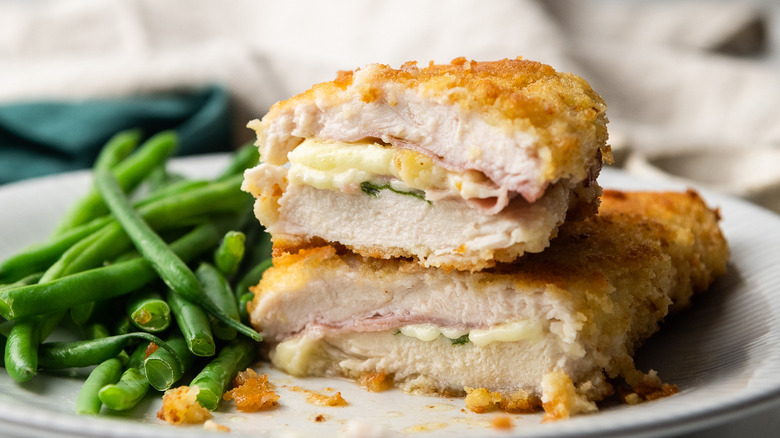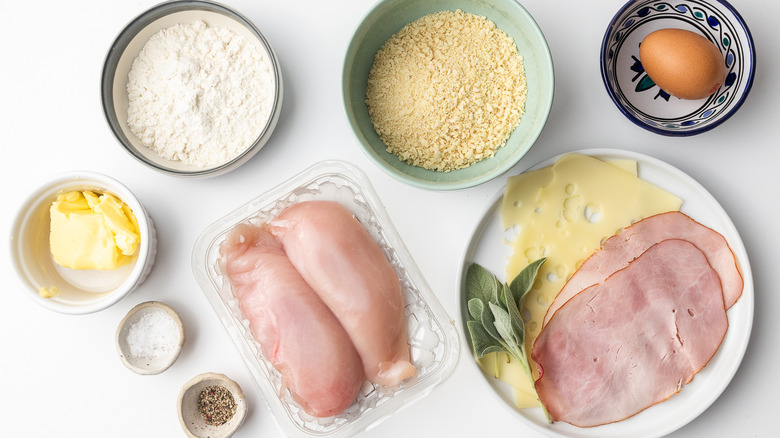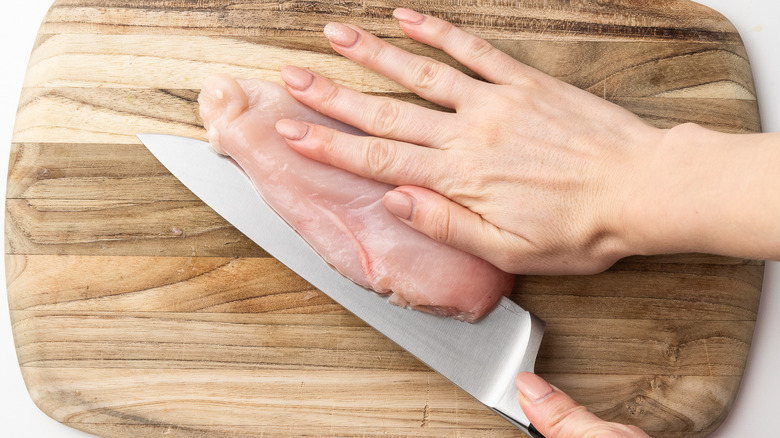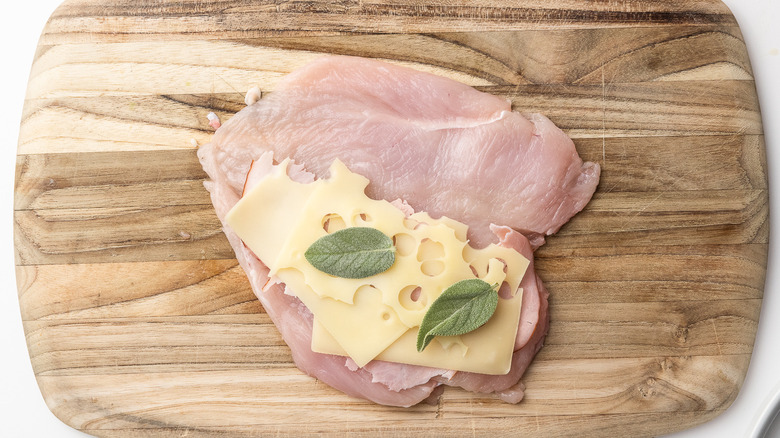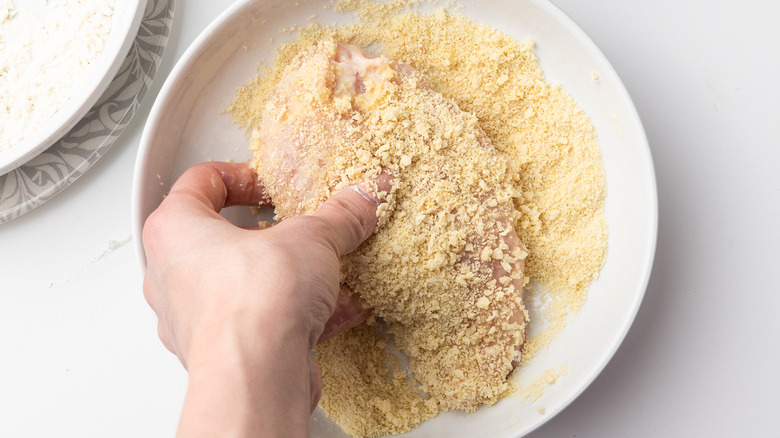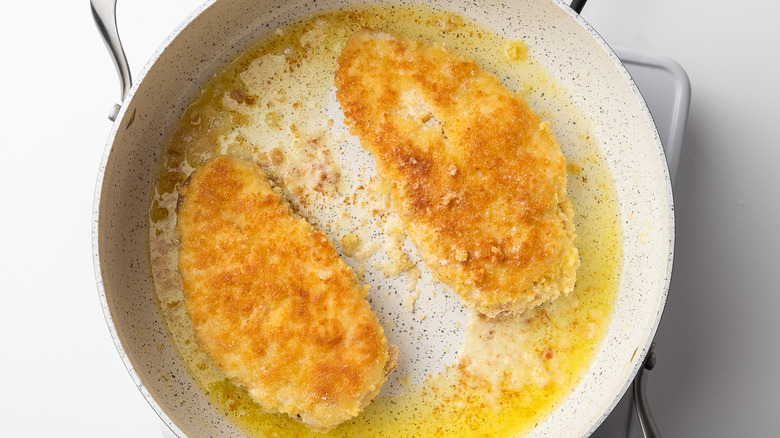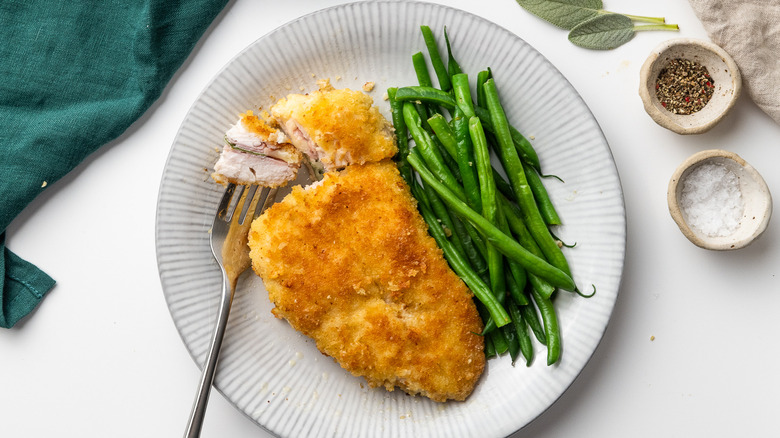Classic Chicken Cordon Bleu Recipe
If you are looking for a fun way to spice up your average chicken breast, look no further than this classic chicken cordon bleu. As the title suggests, this is an iconic dish that has been around for quite some time. According to JuleeHo, this first iteration of this recipe came about in the 1840s, and there's a good chance that it came from another dish called veal kiev, which people in Paris served. The people of Moscow also served a similar dish, but instead of veal, they opted for chicken. If you're still following along, veal cordon bleu came to the United States in the 1950s, and chicken cordon bleu came here in 1967.
Recipe developer Jennine Bryant came up with this tasty dish that could earn a spot on your monthly menu rotation. "I love how simple this recipe is to do, yet how impressive it seems to serve up for guests. It's a great option for a simple dinner party meal or when friends or family come over," Bryant shares. "You can make it up to the point where it is breaded and just needs cooking, and then pop it in the fridge until later on for a quick meal."
Gather the ingredients for this classic chicken cordon bleu
As with any other recipe, you will first need to make a list of ingredients and head to the grocery store. This recipe requires a few things, making your trip to the store a breeze. Pick up plain flour, salt, pepper, chicken breasts, smoked ham, Emmental cheese, sage leaves, an egg, dried breadcrumbs, and unsalted butter.
Once you have those things, you can whip up this classic chicken cordon bleu.
Mix the flour, salt, and pepper then cut and pound chicken
For this step, you will need to take out a wide, flat bowl that you will eventually dip the chicken in. Add the flour first, followed by the salt and pepper. Since the salt and pepper are "to taste," you can add as much or as little as you want based on your preferences. Use a whisk to combine the seasoning, and then set the bowl aside for the time being.
Next, cut each of the chicken breasts horizontally, most of the way through. Be sure to stop to leave a little bit of chicken to keep the breast intact rather than cutting the whole thing apart. Open each breast to make a heart shape and then cover them in plastic wrap. Use either a heavy rolling pin or a mallet to flatten the chicken to about ⅓ inch thick.
Stuff the chicken breasts
If you've made chicken cordon bleu before, you know that you need to stuff the breasts with goodies. Remove the plastic wrap from the chicken and add a slice of ham and then a slice of cheese to the center of the breasts.
Then, place two sage leaves on top of the cheese. Fold one half of the chicken breast over the other, so the chicken basically serves as the "sandwich bread" with the filling in the middle. Be sure to press down lightly to secure it.
"The secret ingredient in this is the fresh sage leaves that are hidden inside the chicken. Adding the earthy herbal flavor of sage really increases how fancy the dish tastes. It would be fine without it, but it really becomes special with the sage addition," Bryant explains. "Sage also pairs nicely with the cheese and enhances the flavor of the Emmental."
Make the other bowls for the dredging station and coat the chicken
You already have the flour mix ready to go, but there are still two more bowls you will need for dipping. Add the egg and whisk in gently with a fork in another wide, flat bowl. Then, you can toss the breadcrumbs in your third wide and flat bowl.
Line up your three dredging bowls and the stuffed chicken breasts. It's easiest to do one breast at a time. First, dip it in the seasoning flour, followed by the egg mixture. Make sure to dip both sides well. Last but not least, dunk the breasts in the breadcrumbs, again covering the top and bottom of the chicken.
Repeat the same steps with your remaining chicken breast.
Fry the chicken
Now that your chicken is fully coated and ready to go, take out a large frying pan and place it on your stove. Add the butter and let it heat until melted and lightly foamy. "In general, I would say that the temperature setting should be kept to a low medium," Bryant shares. "Really, the key is to keep watching what the butter is doing. Ideally, it should be lightly bubbly and gently foamy, so it is hot enough to cook the chicken and make the breadcrumbs a beautiful golden color, but also not too hot that it ends up burning. You also don't want it to be too low that it doesn't cook the chicken and the crumbs just absorb the butter and go soggy. So, it's good to keep an eye on the pan while cooking these!"
Place the chicken breasts into the pan and let them cook for 7 minutes on each side. Once the breasts finish cooking, the cheese should be melted and the chicken should be cooked through and no longer pink. You can always cut into one of the breasts to ensure it's done before removing it from the pan.
Let the chicken sit and serve
Remove the chicken from the pan and let it sit and cool off for a few minutes before serving. This dish is excellent on its own, thanks to the combination of chicken, cheese, ham, and breading, but Bryant suggests a few of her favorite sides to accompany the classic chicken cordon bleu. "I love a simple side of fresh vegetables with this, and maybe a few boiled new potatoes," Bryant explains. "It's so rich and decadent by itself that it doesn't need any further powerful flavors or richness added, but some steamed green beans or broccoli cut through that richness perfectly, adding lightness, freshness and also color to the plate."
Anything left? Bryant suggests keeping the chicken in an "airtight container for 3 days." She adds, "They can either be carefully and thoroughly reheated in the oven, or, my favorite option: Slice it and eat it cold in a sandwich!" A leftover sandwich sounds incredible.
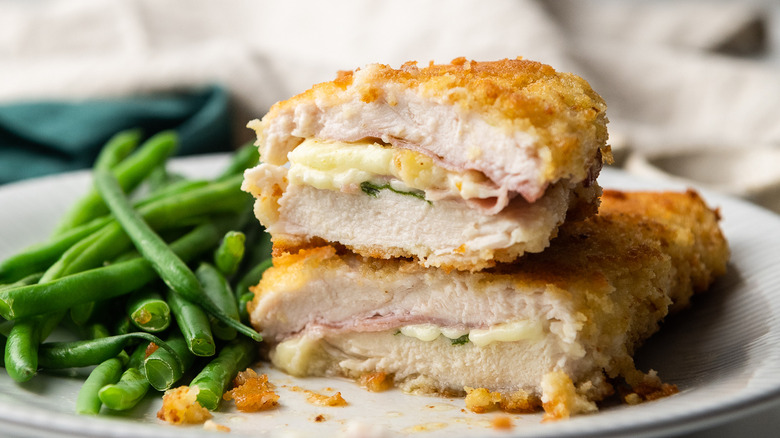
- ¼ cup plain flour
- Salt and pepper, to taste
- 2 chicken breasts
- 2 slices smoked ham
- 2 slices Emmental cheese
- 4 sage leaves
- 1 large egg, room temperature
- ½ cup dried breadcrumbs
- ⅓ cup unsalted butter
- Place the flour into a wide, flat bowl and season with salt and pepper to taste. Mix to combine the seasoning and then set the bowl to one side.
- Using a sharp knife, cut both of the chicken breasts horizontally most of the way through, stopping just short of cutting them in half.
- Open the chicken breasts out into a heart shape, cover them with plastic wrap and then, using a heavy rolling pin or a mallet, gently flatten the chicken until it is roughly ⅓ inch thick.
- Remove and dispose of the plastic wrap, and place a slice of ham, a slice of cheese, and two sage leaves onto one half of each chicken breast. Fold one half of the chicken breasts over the other half and press down lightly.
- Break the egg and whisk it gently with a fork, and place into a wide, flat bowl. Place the breadcrumbs into another wide, flat bowl.
- Taking one chicken breast at a time, coat with the seasoned flour, and then coat in the egg mixture, then finally cover thoroughly with breadcrumbs.
- In a large frying pan, gently heat up the butter until it is melted and lightly foaming. Place the chicken breasts into the pan and allow them to gently cook on one side for 7 minutes, before turning and cooking for another 7 minutes on the other side. The cordon bleu are ready when the chicken is cooked through and the cheese has melted.
- Once ready, remove the cordon bleu from the pan and allow to sit for a few minutes before serving.
| Calories per Serving | 924 |
| Total Fat | 61.1 g |
| Saturated Fat | 31.0 g |
| Trans Fat | 1.8 g |
| Cholesterol | 320.0 mg |
| Total Carbohydrates | 35.7 g |
| Dietary Fiber | 2.7 g |
| Total Sugars | 2.0 g |
| Sodium | 782.4 mg |
| Protein | 56.7 g |
